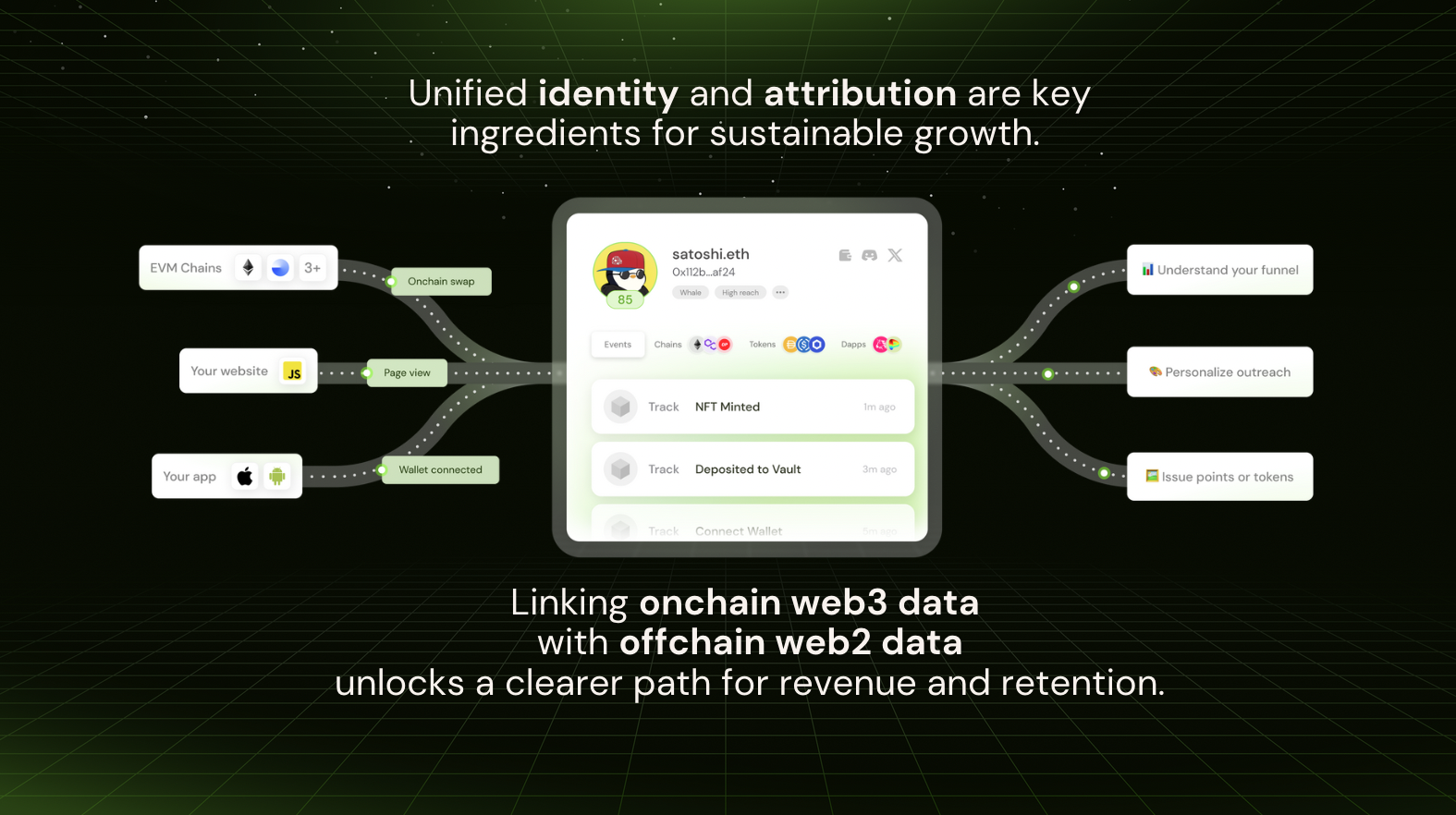Overview
User acquisition is one of the biggest problems in crypto. For an app to succeed, it must have sustainable unit economics when it comes to user acquisition. The lifetime revenue of a user (LTV) should be greater than the cost to acquire them (CAC) at a healthy multiple.
- Where did users come from?
- What meaningful activity did users perform on my app?
- How well are users monetizing? How much revenue did I make? (ARPU, LTV)
- How long are users sticking around? (Retention, Churn)
- Is my ROI for an acquisition channel positive? (LTV > CAC)
Example
Attribution in web3 is complex. As you’ve seen in the above example, not everything you care about is onchain. Consider the following example user journey for a DEX called FooSwap with many touchpoints:- A user sees an tweet thread about an app on X (“referrer”) clicks on a referral link
- The user visits the app’s website (fooswap.com)
- The user visits the app (app.fooswap.com)
- The user connects their wallet on the app
- The user signs a token approval message
- The user starts a swap transaction but the wallet has insufficient gas
- The user abandons their transaction (“dropoff”)
- The user revisits the app from another channel on Farcaster (“referrer”)
- The user completes a swap transaction (“conversion”) emitting an onchain event
- Using first touch model, the complete conversion can be attributed to X and the referral
- Using last touch model, the complete conversion can be attributed to Farcaster
- Using a linear attribution model, we could assign a weight of 0.5 to each touchpoint, meaning that both X and Farcaster contributed equally to the conversion
How attribution works in Formo
To understand the full user journey, we must navigate two different worlds: offchain and onchain. It’s imperative to trace the event sequence from initial engagement offchain to conversion onchain. Here’s a high-level overview of how it works: Formo solves two core functions: attribution and identity.- Attribution refers to event-based analytics about where, how, and when users interact with links, sites, and apps (touchpoint trackers, UTM & referral parameters, events, ingestion).
- Identity refers to the resolution of user activity into a single unified profile (sessions, demographics, wallets, onchain data).
Attribution models
Formo helps you understand the impact of each touchpoints in each user journey, whether with first or last touch (single-touch attribution) or across multiple touchpoints using multi-touch attribution.| Model | Description |
|---|---|
| First Touch | Gives 100% credit to the first touchpoint within the attribution lookback window |
| Last Touch | Gives 100% credit to the last touchpoint within the attribution lookback window |
| Linear | Gives equal credit to every touchpoint leading up to a conversion within the lookback window |
Looking for more attribution models? Let us know.
Glossary
| Term | Definition |
|---|---|
| User journey | Consists of touchpoints and the conversion event. It is possible for a conversion event to have no corresponding touchpoints (eg. utm parameters). In this case we consider it a ‘direct’ conversion |
| Conversion | The primary event you’re interested in analyzing with multi-touch attribution models. Typically some final value generating interaction such as “Mint” or “Swap” or “Stake”. |
| Touchpoint | Actions (events) a user’s taken or exposed to along the journey before doing the conversion event. [Eg. does event A → B → C → D (conversion event) in a 7 day period; For a lookback window of 7 days, A, B, C are all considered touchpoints] |
| Lookback window | The time window where a user’s events with this attribution property are counted towards the calculation. The window ends when the conversion metric happens. |